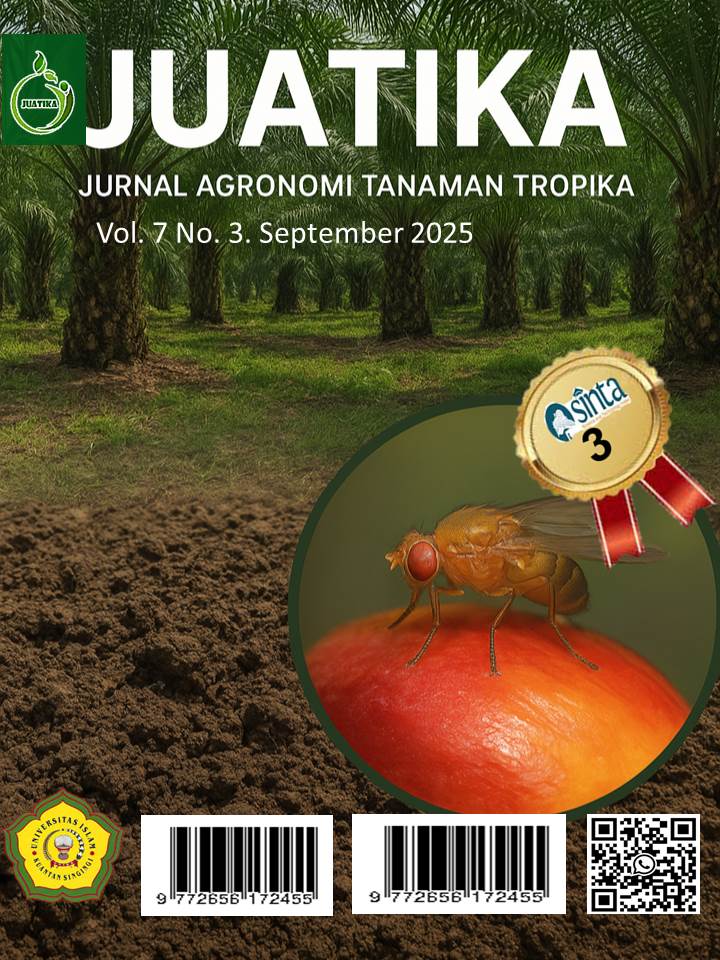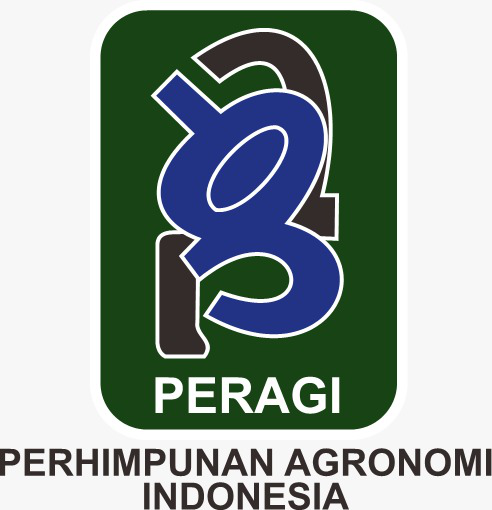Improving the Quality of Coconut Fruit (Cocos nucifera L.) by Adjusting Planting Age
Abstract
Coconut (Cocos nucifera L.) is a strategic plantation crop in Indonesia, playing important roles in society, the economy, and industry. Indragiri Hilir Regency is the largest producer of coconut in Riau Province; however, productivity has declined as plantations have aged. This study aimed to analyze the quality of coconut fruit based on plant age. A non-experimental comparative observational design was employed with three plant age treatments (15, 20, and 25 years). Each treatment was replicated six times, yielding 18 experimental units. Each unit consisted of two sample plants, totaling 36 plants. The measured parameters included endosperm thickness (mm), oil yield (%), and oil moisture content (%). For oil yield and moisture analysis, two mature coconuts were collected from each plant and analyzed in the laboratory, resulting in 36 samples. Data were analyzed using one-way ANOVA, and significant results were further tested using Tukey's HSD at the 5% level. The results showed that plant age had a considerable effect on endosperm thickness, oil yield, and moisture content. These findings suggest that plant age affects coconut fruit quality, with 25-year-old trees producing the highest-quality fruits in the Tembilahan Hulu District, Indragiri Hilir Regency. This study offers recommendations for coconut farmers to optimize cultivation strategies, thereby enhancing production and fruit quality.
Downloads
References
Banowati, G., & Nurhidayati, A. R. (2021). Pengaruh umur buah kelapa terhadap rendemen minyak VCO (Virgin coconut oil). Mediagro, 17(1), 57–66.
Christianty, M. A., Martono, Y., & Riyanto, C. A. (2018). Seminar nasional biologi dan pendidikan biologi UKSW 2018. Prosiding Seminar Nasional Biologi dan Pendidikan Biologi UKSW 2018, 157–162.
Clark, A. L., & McMurray, J. J. (2021). Physiology and heart failure. In Heart Failure (pp. 112–122).
Damanik, S. (2015). Strategi pengembangan agribisnis kelapa (Cocos nucifera) untuk meningkatkan pendapatan petani di Kabupaten Indragiri Hilir, Riau. Agrica, 6(2), 94–104.
Khairizal, Vaulina, S., & Wahyudy, H. A. (2018). Analisis faktor yang memengaruhi produksi kelapa dalam (Cocos nucifera L.) pada lahan gambut dan lahan mineral di Kabupaten Indragiri Hilir Provinsi Riau. Jurnal Dinamika Pertanian, 35(3), 191–200.
Mahmud, Z., & Ferry, Y. (2005). Prospek pengolahan hasil samping buah kelapa. Perspektif, 4(2), 55–63.
Muis, A., Riset, B., Standardisasi, D., & Manado, I. (2016). Pengaruh metode pengolahan dan umur panen kelapa terhadap kualitas dan kandungan senyawa fenolik Virgin coconut oil (VCO). Jurnal Penelitian Teknologi Industri, 8(2), 97–106.
Sari, W. K., & Rusmanida, R. (2023). Perbandingan rendemen kelapa sawit (Elaeis guineensis Jacq.) di perkebunan rakyat dan perkebunan PT Tidar Kerinci Agung. Jagur Jurnal Agroteknologi, 5(1), 7–15. https://doi.org/10.25077/jagur.5.1.7-15.2023
Subagio, A. (2011). Potensi daging buah kelapa sebagai bahan baku pangan bernilai. Pangan, 20(1), 15–26.
Tarigans, D. D. (2015). Diversifikasi usahatani kelapa sebagai upaya untuk meningkatkan pendapatan petani. Perspektif, 4(2), 71–78. http://download.garuda.kemdikbud.go.id/article.php?article=1671976&val=18132
Winarti, W., Rahmadi, S., & Parmadi, P. (2022). Faktor-faktor yang memengaruhi produksi kelapa dalam di Kabupaten Tanjung Jabung Barat. Jurnal Ekonomi Aktual, 1(3), 141–148. https://doi.org/10.53867/jea.v1i3.56
Wulandari, K., & Anggraeni, R. (2018). Analisis faktor yang memengaruhi produktivitas kelapa di Kecamatan Panjatan, Kabupaten Kulon Progo. Jurnal Pertanian Agros, 20(1), 29–38.
Yunidawati, W. (2022). Faktor-faktor yang memengaruhi produksi kelapa: Studi kasus di lahan perkebunan rakyat. Fruitset Sains: Jurnal Pertanian Agroteknologi, 10(5), 262–268. https://iocscience.org/ejournal/index.php/Fruitset/article/view/3358/2549
Copyright (c) 2025 Eko Wahyudi, M. Amrul Khoiri, Qory Fadillah Cahya, Anthony Hamzah , Rizki Al Khairi Barus

This work is licensed under a Creative Commons Attribution 4.0 International License.
Authors who publish with Jurnal Agronomi Tanaman Tropika (JUATIKA) agree to the following terms:
Authors retain copyright and grant the Jurnal Agronomi Tanaman Tropika (JUATIKA) right of first publication with the work simultaneously licensed under a Creative Commons Attribution License (CC BY 4.0) that allows others to share (copy and redistribute the material in any medium or format) and adapt (remix, transform, and build upon the material for any purpose, even commercially) with an acknowledgment of the work's authorship and initial publication in Jurnal Agronomi Tanaman Tropika (JUATIKA).
Authors are able to enter into separate, additional contractual arrangements for the non-exclusive distribution of the journal's published version of the work (e.g., post it to an institutional repository or publish it in a book), with an acknowledgment of its initial publication in Jurnal Agronomi Tanaman Tropika (JUATIKA). Authors are permitted and encouraged to post their work online (e.g., in institutional repositories or on their website) prior to and during the submission process, as it can lead to productive exchanges, as well as earlier and greater citation of published work.







 More Information
More Information



